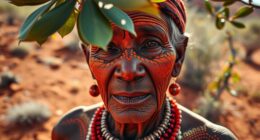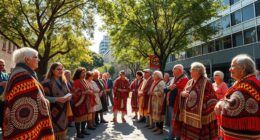Australia’s linguistic landscape goes beyond the large Pama–Nyungan family, featuring many unique non-Pama–Nyungan languages. These include isolated languages and smaller families mainly found in the north and west. They reveal a rich history of migration, cultural resilience, and ancient settlement across the continent. Each language offers clues about Australia’s diverse past. If you explore further, you’ll uncover fascinating stories about these lesser-known languages and their place in Australia’s heritage.
Key Takeaways
- Non-Pama–Nyungan languages form a diverse set of independent language families and isolates across northern and western Australia.
- They offer insights into ancient migration patterns and cultural histories outside the dominant Pama–Nyungan family.
- These languages showcase unique phonetic, syntactic, and lexical features, highlighting Australia’s linguistic mosaic.
- Many are endangered, emphasizing the importance of documentation and revitalization efforts.
- Understanding these languages enriches knowledge of Australia’s complex heritage beyond the widespread Pama–Nyungan family.

Have you ever wondered how the diverse languages of Australia extend beyond the well-known Pama–Nyungan family? While most people associate Australian Indigenous languages with the expansive Pama–Nyungan family, a significant number of languages fall outside this classification. These non-Pama–Nyungan languages represent a fascinating patchwork of linguistic diversity, reflecting complex historical migrations and unique cultural histories. When exploring this diversity, understanding language classification becomes essential. Unlike Pama–Nyungan, which forms a large, interconnected family, non-Pama–Nyungan languages are often classified into smaller, isolated groups. Many of these languages belong to distinct language families or are language isolates, meaning they have no proven relation to other languages. This classification helps linguists trace the origins and relationships of these languages, revealing a tapestry of ancient connections and separations.
The presence of non-Pama–Nyungan languages in Australia points to a rich history of migration and settlement, long before European contact. These languages are primarily found in the northern and western parts of the continent, areas that archaeological evidence suggests were some of the earliest inhabited regions. As groups migrated across the continent, they carried their languages with them, often adapting and evolving in response to local environments and interactions with neighboring groups. The diversity among non-Pama–Nyungan languages indicates multiple waves of migration, each bringing distinct linguistic influences. Some groups may have arrived from distant regions, bringing languages unrelated to the Pama–Nyungan family, while others developed in relative isolation, preserving older linguistic features.
Studying these languages offers a glimpse into Australia’s ancient past, highlighting how migration patterns shaped the continent’s linguistic landscape. Despite their smaller numbers and the challenges posed by language extinction, these languages provide invaluable insights into human history and cultural resilience. Many of these languages are endangered, with only a few speakers remaining, but efforts are underway to document and revitalize them. By examining the unique features of non-Pama–Nyungan languages—such as their phonetics, syntax, and vocabulary—you gain a deeper appreciation for the continent’s complex history of human movement and interaction. Ultimately, these languages remind us that Australia’s linguistic heritage isn’t solely defined by the vast Pama–Nyungan family; it’s a mosaic that includes many smaller, equally fascinating linguistic stories shaped by ancient migration and cultural diversity.
Frequently Asked Questions
How Many Non-Pama–Nyungan Languages Are Currently Spoken?
You’ll find around 100 non-Pama–Nyungan languages still spoken today, representing a diverse range of linguistic classifications across Australia. These languages face challenges in preservation, but efforts are ongoing to keep them alive. By supporting language preservation initiatives, you help guarantee these unique languages aren’t lost. Each language holds cultural significance, and maintaining their use enriches Australia’s linguistic diversity beyond the main family.
What Are the Main Challenges in Documenting These Languages?
You face several challenges in documenting non-Pama–Nyungan languages. Limited resources and remote locations make linguistic documentation difficult, while small speaker populations increase the risk of language loss. Effective community engagement is essential to gather accurate data and guarantee cultural respect. Without strong collaboration with local communities, preserving these languages becomes harder. Balancing technical research with community needs is key to successful documentation efforts.
How Do Non-Pama–Nyungan Languages Influence Australian Cultural Identity?
Imagine a tapestry, vibrant and intricate, much like how non-Pama–Nyungan languages shape Australian cultural identity. You influence this through cultural expression and linguistic pride, embracing diverse stories and traditions. These languages highlight unique worldviews, fostering a sense of belonging and resilience. By celebrating these linguistic varieties, you help preserve Australia’s rich heritage, inspiring future generations to value cultural diversity and strengthen national identity beyond mainstream narratives.
Are Any Non-Pama–Nyungan Languages Being Revitalized?
Yes, some non-Pama–Nyungan languages are being revitalized through community-led initiatives and language revitalization efforts. You can see local communities actively working to preserve and teach these languages, often involving elders and young people. These efforts aim to strengthen cultural identity and guarantee the languages are passed down. By supporting these initiatives, you help keep these diverse languages alive and vibrant for future generations.
What Regions Outside Australia Have Similar Language Diversity?
You’ll find regions outside Australia with rich linguistic diversity, such as Papua New Guinea, which has over 800 languages, and Africa, home to thousands of unique languages. These areas emphasize language preservation efforts to protect their linguistic heritage. Engaging in local initiatives, supporting documentation projects, and promoting community-led revitalization help maintain this diversity. Recognizing the importance of these languages guarantees they’re preserved for future generations.
Conclusion
Just as the stars remind us there’s more to the universe than what we see, these non-Pama–Nyungan languages reveal a hidden tapestry of human diversity. Their unique structures and histories challenge us to look beyond familiar patterns, urging you to appreciate the richness that lies beyond the main family. By exploring these lesser-known tongues, you uncover a deeper understanding of humanity’s endless capacity for variation—proof that, like the night sky, our cultural landscape is vast and full of wonder.
Mary is a passionate writer who brings creativity and a fresh perspective to our team. Her words have the power to captivate and inspire, making her an essential contributor to our content. Mary’s commitment to storytelling and dedication to promoting Indigenous culture ensures that her work touches the hearts of our readers. We’re fortunate to have her as part of our team.









